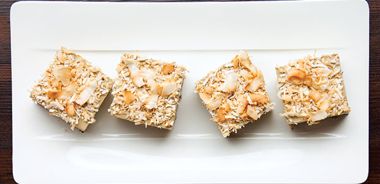Avocado Lime Cheesecake Bars

While cheesecake normally provides an avalanche of calories from cheese and cream, this healthier citrusy version obtains many of its fat calories from nuts and creamy nutrient-dense avocado. Plus, it’s no-bake! Consider sprinkling some coconut flakes on top. Placing a sheet of parchment paper over the cheesecake will also help keep it from browning too much during storage.
2 cups (500 mL) organic rolled oats
3/4 cup (180 mL) pecans
1/2 cup (125 mL) dried cranberries
1/4 cup (60 mL) melted coconut oil
2 Tbsp (30 mL) honey
1 in (2.5 cm) piece fresh ginger, grated or finely minced
1 Tbsp (15 mL) unflavoured gelatin or agar-agar powder
1 1/4 cups (310 mL) milk
1/4 cup (60 mL) coconut sugar, sucanat, or other raw-style sugar
Zest of 2 limes
1 tsp (5 mL) vanilla extract
Juice of 1 lime
2 ripe medium-sized avocados
8 oz (225 g) cream cheese, room temperature
Place oats and pecans in food processor container and process until pulverized. Add cranberries, oil, honey, and ginger; process until mixture sticks together when pressed between your fingers.
Place a long piece of parchment paper on bottom of square 8 x 8 x 2 in (2 L) cake pan so that it extends up two sides of pan and overhangs on both sides. Place another long piece of parchment paper perpendicular to the first. This will make it easier to remove prepared bars. Place oat mixture in pan and press down firmly to form even, flat crust. Place pan in refrigerator while you prepare topping.
Stir together gelatin and 2 Tbsp (30 mL) water in small bowl; let sit 5 minutes. Bring milk, sugar, lime zest, and vanilla to boil in medium-sized saucepan. Add gelatin and lime juice; stir until gelatin has dissolved.
Purée avocado flesh and cream cheese together in food processor. Add hot milk mixture and blend until combined. Pour avocado mixture over crust in pan and refrigerate until set, at least 2 hours. Slice into 12 bars.
Serves 12.
Each serving contains: 364 calories; 8 g protein; 23 g total fat (9 g sat. fat, 0 g trans fat); 36 g total carbohydrates (14 g sugars, 6 g fibre); 94 mg sodium
source: "Sweets for Your Sweetheart", alive #376, February 2014





